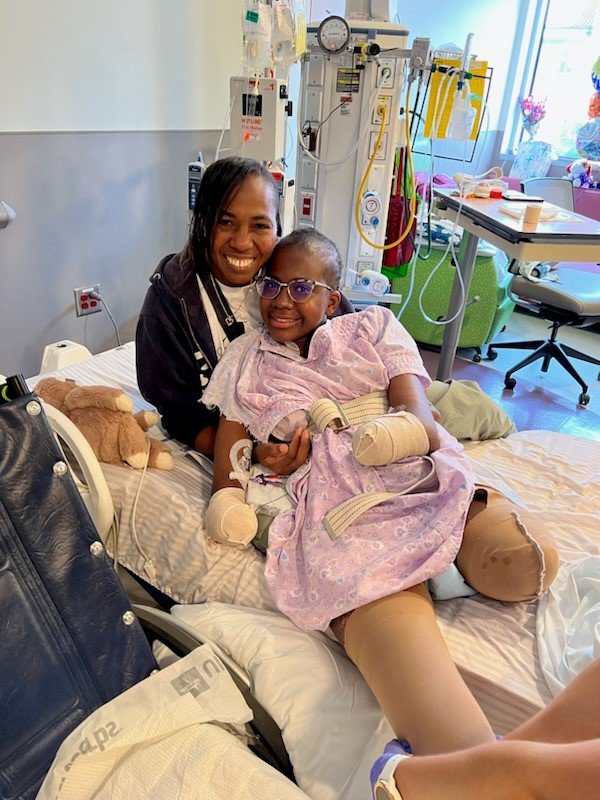Teen Clings to Faith After Limb Amputation
Natalya Manhertz may never understand how a sore throat led to the amputation of all four of her limbs, but, with steadfast faith, and the love of her family and friends, she is reminded that she’s still the same “Nat.”
It was May 2023, the end of Manhertz’s junior year at Trinity Christian School in Sharpsburg, when she developed a sore throat. After a weekend of discomfort, she missed school the following Monday, and still didn’t feel well when she returned to school Tuesday.
“I asked a friend to drop me off at the front door of the building, because the walk from the parking lot was too far. I felt like I’d pass out,” said Manhertz,18.
When she entered the school, her principal instantly recognized that Manhertz wasn’t well and sent her to the nurse’s office. The nurse called her mom and suggested she take her daughter to urgent care.
Manhertz was treated for a migraine at urgent care and sent home. Hours later she woke from a nap with a throbbing head, bloody nose, and pain throughout her body. Her mom rushed her to the local hospital emergency room where she was diagnosed with strep throat and where medical staff made the shocking discovery that Natalya’s organs were failing. She received a blood transfusion and was life-flighted to Children’s Healthcare of Atlanta Egleston Hospital.
“I was all over the place, crying, shock, all of it,” said her mother, Thelia Manhertz. “The doctor said she had Group A Strep and septic shock. I had never even heard of sepsis.”
Soon after arriving at Children’s, Manhertz went into cardiac arrest. With no time to spare, her mother gave verbal permission for her daughter to be placed on an ECMO machine to keep her heart and lungs functioning. Doctors explained Manhertz could die on the machine and said she would certainly die without it.
Thelia Manhertz was told her daughter could remain on the ECMO machine for months and was relieved when she was able to be taken off after five days. But when they took her off the machine, Manhertz’s limbs were cold. The machine kept her alive, but her limbs suffered from lack of blood flow.
Manhertz, a 5-foot-10-inch tennis player, learned her hands would be amputated up to her forearms, and her long legs would also be amputated, the right one to right below her knee, the left above the knee.
“I was crying, so scared when I found out. The first thing I thought was I’m going to die,” said Manhertz. “My mom cried when she told me. I’d never seen my mom cry before in my life.”
Dr. Vipin Bansal, a pediatric anesthesiologist at Children’s, met with Manhertz before the surgery.
“We see amputations all the time, but not all four limbs,” said Bansal. “Her arms and legs looked like burned matches. It breaks your heart. Everyone at Children’s came together to help this girl – nurses, doctors – we all love her.”
Due to intense medication, Manhertz’s long, black hair fell out. On July 10, the day of her leg amputation, the nurses and doctors wore wigs to make Manhertz smile. She also wore a wig up till surgery.
“I felt a bit of relief after my leg surgery, because they had developed gangrene and I knew it was time,” said Manhertz.
Just days later, on July 14, Manhertz was wheeled into her second surgery.
“I was more prepared for the hands,” said Manhertz. “I saw my fingers drying up, no life left.”
While both operations went as expected, Manhertz experienced intense pain in her left leg, including phantom pain, a terrible sensation that felt as if her leg was still there. Bansal, who specializes in acute chronic pain, had a solution in mind.
“Nerve stimulators are something Emory does, but never at Children’s,” said Bansal. “Wires are placed next to the nerves, and they retrain the pain signals in the leg and brain. Children’s went the extra mile and gave us approval for the nerve stimulator within a week. We’re the first to use it on someone so young and it was successful in alleviating Nat’s pain.”
Manhertz was transferred to Children’s Healthcare of Atlanta Scottish Rite Hospital for rehabilitation. She was released Oct. 4, five months after the onset of her initial symptoms.
“I have days where I just want to get in my car and drive around like a normal teenage girl, but I can’t do that anymore,” said Manhertz. “Adjusting to my new life is weird. My friends tell me I’m the same Nat as before. I get all the tea, they come over and we hang out like we normally would. And I’m going to prom in March. I didn’t originally want to go because I don’t want my power wheelchair to bump into people on the dance floor, but my friends make me feel really comfortable. And this is my senior year.”
Manhertz and her mother are passionate about bringing more awareness to sepsis, insisting the Centers for Disease Control is not doing enough education, especially in schools. Manhertz still plans to attend college to pursue the dream she’s had for years.
“I still want to be a sports broadcaster,” she said. “Once I have my new hands and legs, people will see me on TV and be like ‘OMG, she has prosthetic hands, robotic legs, and she is doing it.’ I want to be a voice for people like me.”
Thelia Manhertz is amazed by her daughter. She said her daughter gets her strength from the Lord and she gets her strength from her child.
“We are Christians, and we believe in God,” said Manhertz. “Faith helps me when I feel down. Getting my legs and hands cut off has affected my confidence, but I take a step back and think, God spared my life. I’ve been told many times that I should have died. But God.”



